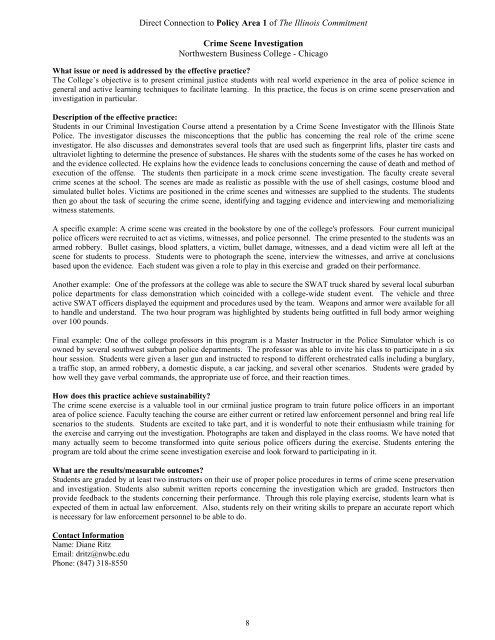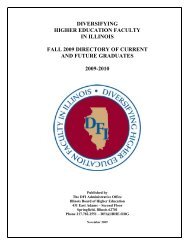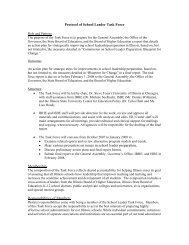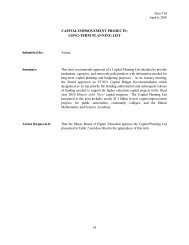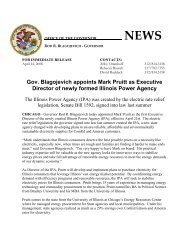Title of Effective Practice: - California Postsecondary Education ...
Title of Effective Practice: - California Postsecondary Education ...
Title of Effective Practice: - California Postsecondary Education ...
You also want an ePaper? Increase the reach of your titles
YUMPU automatically turns print PDFs into web optimized ePapers that Google loves.
Direct Connection to Policy Area 1 <strong>of</strong> The Illinois Commitment<br />
Crime Scene Investigation<br />
Northwestern Business College - Chicago<br />
What issue or need is addressed by the effective practice?<br />
The College’s objective is to present criminal justice students with real world experience in the area <strong>of</strong> police science in<br />
general and active learning techniques to facilitate learning. In this practice, the focus is on crime scene preservation and<br />
investigation in particular.<br />
Description <strong>of</strong> the effective practice:<br />
Students in our Criminal Investigation Course attend a presentation by a Crime Scene Investigator with the Illinois State<br />
Police. The investigator discusses the misconceptions that the public has concerning the real role <strong>of</strong> the crime scene<br />
investigator. He also discusses and demonstrates several tools that are used such as fingerprint lifts, plaster tire casts and<br />
ultraviolet lighting to determine the presence <strong>of</strong> substances. He shares with the students some <strong>of</strong> the cases he has worked on<br />
and the evidence collected. He explains how the evidence leads to conclusions concerning the cause <strong>of</strong> death and method <strong>of</strong><br />
execution <strong>of</strong> the <strong>of</strong>fense. The students then participate in a mock crime scene investigation. The faculty create several<br />
crime scenes at the school. The scenes are made as realistic as possible with the use <strong>of</strong> shell casings, costume blood and<br />
simulated bullet holes. Victims are positioned in the crime scenes and witnesses are supplied to the students. The students<br />
then go about the task <strong>of</strong> securing the crime scene, identifying and tagging evidence and interviewing and memorializing<br />
witness statements.<br />
A specific example: A crime scene was created in the bookstore by one <strong>of</strong> the college's pr<strong>of</strong>essors. Four current municipal<br />
police <strong>of</strong>ficers were recruited to act as victims, witnesses, and police personnel. The crime presented to the students was an<br />
armed robbery. Bullet casings, blood splatters, a victim, bullet damage, witnesses, and a dead victim were all left at the<br />
scene for students to process. Students were to photograph the scene, interview the witnesses, and arrive at conclusions<br />
based upon the evidence. Each student was given a role to play in this exercise and graded on their performance.<br />
Another example: One <strong>of</strong> the pr<strong>of</strong>essors at the college was able to secure the SWAT truck shared by several local suburban<br />
police departments for class demonstration which coincided with a college-wide student event. The vehicle and three<br />
active SWAT <strong>of</strong>ficers displayed the equipment and procedures used by the team. Weapons and armor were available for all<br />
to handle and understand. The two hour program was highlighted by students being outfitted in full body armor weighing<br />
over 100 pounds.<br />
Final example: One <strong>of</strong> the college pr<strong>of</strong>essors in this program is a Master Instructor in the Police Simulator which is co<br />
owned by several southwest suburban police departments. The pr<strong>of</strong>essor was able to invite his class to participate in a six<br />
hour session. Students were given a laser gun and instructed to respond to different orchestrated calls including a burglary,<br />
a traffic stop, an armed robbery, a domestic dispute, a car jacking, and several other scenarios. Students were graded by<br />
how well they gave verbal commands, the appropriate use <strong>of</strong> force, and their reaction times.<br />
How does this practice achieve sustainability?<br />
The crime scene exercise is a valuable tool in our crmiinal justice program to train future police <strong>of</strong>ficers in an important<br />
area <strong>of</strong> police science. Faculty teaching the course are either current or retired law enforcement personnel and bring real life<br />
scenarios to the students. Students are excited to take part, and it is wonderful to note their enthusiasm while training for<br />
the exercise and carrying out the investigation. Photographs are taken and displayed in the class rooms. We have noted that<br />
many actually seem to become transformed into quite serious police <strong>of</strong>ficers during the exercise. Students entering the<br />
program are told about the crime scene investigation exercise and look forward to participating in it.<br />
What are the results/measurable outcomes?<br />
Students are graded by at least two instructors on their use <strong>of</strong> proper police procedures in terms <strong>of</strong> crime scene preservation<br />
and investigation. Students also submit written reports concerning the investigation which are graded. Instructors then<br />
provide feedback to the students concerning their performance. Through this role playing exercise, students learn what is<br />
expected <strong>of</strong> them in actual law enforcement. Also, students rely on their writing skills to prepare an accurate report which<br />
is necessary for law enforcement personnel to be able to do.<br />
Contact Information<br />
Name: Diane Ritz<br />
Email: dritz@nwbc.edu<br />
Phone: (847) 318-8550<br />
8


